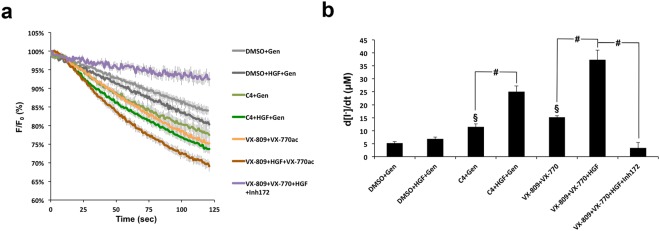Figure 1.
HGF treatment improves functional rescue of Phe508del-CFTR by chemical correctors. (a) Fluorescence decay curves of the iodide influx assay. CFBE-Phe508del cells stably expressing the YFP-halide sensor were treated, as indicated, for 48 h with 10 μM corr-4a (C4) or 3 μM VX-809, in the presence or absence of 50 ng/ml of HGF for the last 24 h. Cells were then stimulated with 5 μM forskolin (Fsk) and either 20 μM genistein (Gen) or 10 μM VX-770, in the presence or absence of 25 μM CFTR inhibitor 172 (inh172). Fluorescence was recorded continuously in a microplate reader, first for 10 s (baseline) and then for 110 s after the rapid (≤1 s) addition of isomolar PBS, in which Cl− was replaced by I−. Fluorescence (F) was plotted over time as percentage of fluorescence at time 0 (F0). Data are means ± SEM of three independent assays. (b) Iodide influx rates calculated by fitting the curves to the exponential decay function to derive the maximal slope that corresponds to initial influx of I− into the cells23. Data are means ± SEM of three independent assays. §p < 0.01 relative to DMSO; #p < 0.001.

